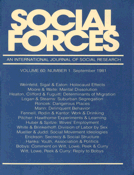-
Views
-
Cite
Cite
John R. Logan, Linda Brewster Stearns, Suburban Racial Segregation as a Nonecological Process, Social Forces, Volume 60, Issue 1, September 1981, Pages 61–73, https://doi.org/10.1093/sf/60.1.61
Close - Share Icon Share
Abstract
In the case of one large northern suburban region, the best predictors of change in racial composition of individual suburbs are the initial black proportion and the presence of white ethnics. The effect of initial racial composition reflects the process of increasing ghettoization of blacks which has commonly been found in the North. Ethnicity is interpreted as a basis for social solidarity in the context of a collective action model of community development. Its effect is found to be limited to working-class suburbs, suggesting that the emergence of ethnicity has some specific class and community bases. Finally, none of a series of community characteristics associated with the ecological life-cycle model has a significant effect on racial change.



